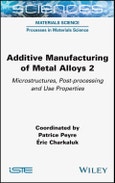Over the last decade or so, additive manufacturing has revolutionized design and manufacturing methods by allowing more freedom in design and functionalities unattainable with conventional processes. This has generated extraordinarily high interest in both industrial and academic communities.
Additive Manufacturing of Metal Alloys 2 puts forward a state of the art of additive manufacturing and its different processes, from metallic raw materials (in the form of powder or wire) to their properties after elaboration. It analyzes the microstructures and post-processing of existing AM materials as well as their use properties.
Using a balanced approach encapsulating basic notions and more advanced aspects for each theme, this book acts as a metal additive manufacturing textbook, as useful to professionals in the field as to the general public.
Table of Contents
Introduction ix
Patrice PEYRE and Éric CHARKALUK
Chapter 1 Microstructures of Metallic Materials from Additive Manufacturing 1
Coordinated by Christophe COLIN
1.1 Solidification microstructures from AM processes 5
1.1.1 Introduction 6
1.1.2 Growth kinetics with local interface equilibrium 9
1.1.3 Loss of local interface equilibrium at high solidification rates 11
1.1.4 Growth morphologies 14
1.1.5 Growth competition between microstructures 17
1.1.6 Selection of grain structures 19
1.1.7 Solidification in additive manufacturing 22
1.1.8 Acknowledgments 23
1.2 Microstructures of steels 23
1.2.1 Steels and additive manufacturing 23
1.2.2 Rapid solidification of steels in AM 24
1.2.3 Phases and phase transformations 27
1.2.4 Cold cracking 34
1.2.5 Examples of as-built microstructures 35
1.2.6 Summary of microstructural features of steels 38
1.3 Microstructures of nickel-based superalloys 39
1.3.1 Nickel-based superalloys and their applications 39
1.3.2 General information on the metallurgy of nickel-based superalloys 39
1.3.3 Two families of superalloys 41
1.3.4 Microstructures of nickel-based alloys resulting from AM: weldable alloys 42
1.3.5 Hard-to-weld superalloys 48
1.3.6 Overview of the microstructures of superalloys 54
1.4 Microstructures of titanium alloys 54
1.4.1 Phases and phase transformations 55
1.4.2 Microstructures of titanium alloys resulting from the DED process 57
1.4.3 Microstructures of titanium alloys from the L-PBF process 62
1.4.4 Microstructures of titanium alloys from the E-PBF process 68
1.4.5 Overview of the microstructures of titanium alloys 73
1.5 Microstructures of aluminum alloys 74
1.5.1 Microstructures induced by L-PBF 74
1.5.2 Microstructures induced by WAAM on aluminum 82
1.5.3 Microstructures induced by DED-LMD 85
1.5.4 Summary of the microstructures of aluminum alloys 87
1.6 Conclusion 88
1.7 References 89
Chapter 2 Post-processing in Additive Manufacturing 99
Coordinated by Brigitte BACROIX
2.1 Surface treatments 99
2.1.1 Introduction 99
2.1.2 Aqueous processes 101
2.1.3 Mechanical processes 114
2.1.4 Physical processes: example of laser polishing 126
2.1.5 Summary of surface treatments 129
2.2 Hot isostatic pressing 131
2.2.1 Introduction 131
2.2.2 Reminder of the mechanisms active during HIP and standard processing 132
2.2.3 Main microstructural modifications caused by HIP post-treatment 135
2.2.4 Link between HIP and mechanical properties for titanium and nickel alloys 138
2.2.5 Overview of HIP 141
2.3 Heat treatments 141
2.3.1 Stress-relieving treatments 142
2.3.2 Homogenization treatments 145
2.3.3 Precipitation and structural hardening 150
2.3.4 Summary of heat treatments for AM 152
2.4 Conclusion 154
2.5 References 155
Chapter 3 The Properties of Parts Produced by Additive Manufacturing 163
Coordinated by Éric CHARKALUK
3.1 Static mechanical properties 164
3.1.1 Test specimens 164
3.1.2 Tensile properties in the as-built case 168
3.1.3 Effect of post-processing on tensile properties 172
3.1.4 Some indications regarding deformation mechanisms 175
3.1.5 Partial conclusions on the tensile properties of alloys obtained by additive manufacturing 177
3.2 Fatigue behavior 177
3.2.1 General fatigue properties 178
3.2.2 Defects 180
3.2.3 Living with defects 183
3.2.4 Post-processing of parts 188
3.2.5 Partial conclusions on the fatigue properties of alloys obtained by additive manufacturing 189
3.3 Creep behavior and resistance 190
3.3.1 Creep deformation mechanisms 191
3.3.2 Creep tests 192
3.3.3 Creep behavior 194
3.3.4 Damage and service life 200
3.3.5 Partial conclusions on the creep properties of additive manufacturing materials 201
3.4 Aqueous and high temperature corrosion of alloys produced by additive manufacturing 202
3.4.1 Effect of chemical composition 202
3.4.2 Effect of microstructure 203
3.4.3 Effect of manufacturing defects 207
3.4.4 Effect of surface roughness 208
3.4.5 Effect of residual stresses 210
3.4.6 Effect of complex geometries and thin walls 210
3.4.7 Effect of pre-oxidation during HIP treatment 211
3.4.8 Alloys developed specifically for additive manufacturing 211
3.4.9 Partial conclusions on the corrosion performance of alloys resulting from additive manufacturing 212
3.5 Properties of architectured materials 213
3.5.1 Application examples 215
3.5.2 Specificities related to the additive manufacturing of architectured materials 226
3.5.3 Partial conclusions on the properties of architectured materials 238
3.6 Conclusion 239
3.7 References 239
Conclusion 253
Patrice PEYRE and Éric CHARKALUK
Abbreviations 255
List of Authors 265
Index 269








